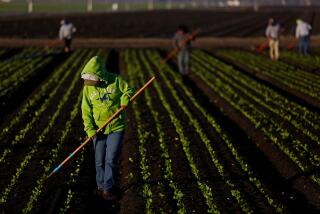Wheat Farmers Going Against the Grain
- Share via
BELLE PLAINE, Kan. — The commodities traders in Chicago, Kansas City and Minneapolis have bid up the price of wheat and corn to historic postwar highs, and Douglas Hisken knows why.
In Hisken’s wheat field, the sprouting weeds--no need to fight them now--are nearly as tall as his grain, which already should have reached thigh-level on his 6-foot, 3-inch frame. The wheat heads, with florets that ripen into berries, are nowhere in sight.
Spring harvest is a month or so away, but Hisken will till this crop right into the ground in about a week, as soon as the insurance adjusters have been by. “It’s just not going to make it,” he said.
By repute, Sumner County--30 miles southwest of Wichita--is the champion wheat-producing county in the nation’s top wheat-producing state. This year, however, it is Ground Zero in a drought-plagued region where crop scouts from the Wheat Quality Council and analysts from brokerage firms have been touring and counting out a somber census.
The annual prairie rite, customarily a march of triumph through the Breadbasket, is a funeral procession instead.
Barren Acreage
In Oklahoma, Texas, Nebraska and Kansas, 40% to 60% of the wheat is estimated to be in poor or very poor condition. Late freezes and thaws also significantly damaged soft wheat (used in cookies and pastries) in Illinois, Missouri, Indiana and Ohio.
Yet Hisken and others in Sumner County are not blind to the upsides of their barren acreage. They are facing a season of high tension but one of opportunity as well.
With new flexibility under the reformed farm bill, they no longer are forced to bring in sparse yields at a subsidized price. Instead, in the first test of a freer farm marketplace, they can rip it out, without the paperwork of the past, and take a chance on planting an extra crop.
Hisken will replace his wheat with grain sorghum and soybeans; others plan on sowing sunflowers or corn. One brokerage firm predicts in a private report that 60% to 80% of Sumner County’s wheat fields will be replanted.
With a little bit of rain--and it finally has been falling--the local farmers may yet participate in the good fortune that their parched land has brought to others. In the meantime, their spending ripples through the ag economy.
Certainly, plenty of money is being made off the scarce supply of grain. Farmers with wheat to sell--mostly in Washington state and Arkansas, or in the few irrigated fields on the Plains--are reaping windfalls.
Farmers who hedged their crop risks by buying futures are benefiting from the frenzied markets, as are countless speculators. Prices, while volatile, have shot at times past $7 a bushel for wheat and $5 a bushel for corn, and they’ve stayed at levels rivaling those of 1947-48, when wartime rationing was in place. The average wheat price for more than a decade has been about $4 a bushel.
To the east, the soil is finally ready for corn, which will be even more sought after with little wheat in sight. Corn acreage is up 12% this year, USDA agricultural economist Sara Schwartz said.
Propelled by high demand--particularly from the Pacific Rim--that has depleted global stocks of both wheat and corn, USDA economists project that aggregate agricultural income will rise sharply in 1996, beating by $2 billion the best take of the decade so far, $48 billion in 1992.
Even here, the rains that came too late to save the wheat gave farmers the moisture they needed to replant. And although the limbo until summer harvest is going to be cash-poor and nerve-racking, “this could end up being the best year ever for a lot of people,” said Eldon Lawless, a wheat farmer who also is executive vice president of the First National Bank in Wellington, the Sumner County seat. “If they can collect an insurance check and raise another crop, they can come out ahead.”
Sorghum in Demand
The most common form of federal crop insurance, Lawless said, will provide about $60 to $80 an acre--while replanting costs should run $40 to $50 an acre. Demand for grain sorghum, used for livestock feed, should be high, especially with shortages of wheat and corn. On a 55-acre test plot last year, the sorghum “made more money than wheat,” said Gerald “Ed” LeValley Jr., Sumner County extension agent for Kansas State University.
The second planting already is helping Hisken, who is also a seed dealer. Sales at his farm have jumped 50% over last year. The rise began in January and February, when the foresighted began to wonder about the impact of the very dry fall on germinating winter wheat.
At the end of an annual promotional event, luring prospective customers with doughnuts and coffee, Hisken totaled up his orders and realized he’d sold 20 more 5,000-pound bags of seed than his distributor had allotted to him.
The Wellington Farmers’ Co-op sold $100,000 worth of sorghum seed this season, compared to less than $15,000 last year, Lawless said.
Nearby, at the Oxford Farmers’ Co-op, manager Rick Houser is still waiting for 150 bags of seed that were supposed to have been delivered more than two weeks ago. Those who didn’t reserve some sorghum, also known in these parts as milo, are desperate.
“They call me on the phone. ‘What can I do?’ I call my man. He can’t find any,” Houser said from his straight-backed armchair inside the co-op shed.
Jim Neises chuckled from the other chair. “If you got the seed bought, you may be able to black-market it,” he said. A 62-year-old wheat farmer, he was passing the time inside because he, too, was waiting for insurance adjusters to evaluate his crop before he plows most of it under.
He and two sons expect to harvest about 400 acres of wheat this year, “if we’re lucky,” out of the 2,000 they planted. “Well,” he said, “looks like we’ll have several thousand acres of milo instead.”
Suppliers agree that farmers will eventually get enough seed for the new planting, but they may not find the exact varieties they want.
The boom is extending to herbicides (there are green bugs about) and to equipment, because a different type of planter is needed for sorghum than for wheat.
Even owners of row crop planters are looking for larger ones, because they never had so much land to plant in alternative crops until this year. Neises’ brother, for example, had a six-row machine and bought a 12-row model for $55,000. Hisken called clear to Montezuma, nearly 200 miles away, seeking a used eight-row version of his six-row planter.
Until the insurance payments come in, many farmers are taking out loans. “There’s no doubt about it, we do have a little bit of a spike right now,” Lawless said. “They’re just starting to come in.”
None of this is easy. For one thing, Sumner County has long resisted other crops. “We’ve got this big attitude,” said grower Tom Morton, which can be seen in the drawings of wheat stalks decorating everything from the big wooden “Welcome to Wellington” sign to the menu at the Wellington Steak House to the sign at the Wheat Country Car Wash.
“This is going to force people to try something else,” said LeValley, who has been touting diversity for years. “Of course, if we don’t get rain this summer, they’ll say, ‘I told you we couldn’t grow this stuff!’ ”
Withered Wheat
The uncertainty grinds on emotions already raw from watching months of effort wither in the fields. It hurts to see the bare spots, to be able to straddle wheat plants easily while walking down a row. They should be so thick and tall the stands must be pushed apart.
It also hurts to watch prices rise in the cities at the prairie’s edge.
At the Chicago Board of Trade, 40 traders in municipal bonds and currency put their names on a waiting list to jump into the hot markets on the agricultural side.
“For our firm, it’s been a dynamo, doubling our volume,” said commodities trader Brian G. Scott of R.J. O’Brien. “For a lot of people, it’s been a bonanza. Millions.”
In the fields, the growers can’t help toting up what might have been, followed by a real-life calculation: “Zero times $6 a bushel is still zero,” said a glum Mike Brown, president of the Kansas Wheat Growers Assn.
“There will be no payday in June,” Morton sighed, “so I’m hoping there will be one in September. But I’m betting on a crop that’s not planted yet.”
Even if the sorghum he plans to sow ripens to great yields, the physical labor will be grueling in the fall, when harvest must be speedy to allow planting of the next round of winter wheat.
At the Sumner County Extension Service office, newsletters displayed on a rack are headed “Stress on the Farm.” Counselors have been invited to speak at several co-ops in the central and western parts of the state.
Of course, no matter how replacement crops turn out, there’s no good news for those who must have wheat or corn, where nothing else will do. Despite the high prices, which also are swinging wildly, demand overseas is bounding upward.
Competing With Asia
American millers and ranchers worry about competing with China and Japan for the stuff of flour and cattle feed. Even bumper crops would not have been enough to fully replenish depleted stocks.
Flour will cost more, but economists say they don’t expect the price of bread to be affected much, because the raw material is such a small component of the finished product. The price of beef, on the other hand, is falling because so many cattle are being slaughtered--and the rising cost of feed is a major factor.
“We have a real problem,” said Terry Francl, senior economist with the American Farm Bureau. “We were going to solve our corn problem by feeding livestock more wheat. We are going to have to liquidate livestock.”
So there was great concern on the three-day swing that the Wheat Quality Council sponsored through Kansas, Oklahoma, Colorado and Nebraska last week. Sixty people--about twice the average--traveled four different routes, stopping 10 or 12 times a day to tramp through fields.
In eastern Kansas, south of the Neosho River, milling company executive David Green stooped over a stunted row. “This is very mediocre,” he said.
John Turner, a USDA crop assessor, knelt nearby, busy with his pocket calculator. “The problem,” Turner said, “is it’s the best we’ve seen today.”
More to Read
Sign up for Essential California
The most important California stories and recommendations in your inbox every morning.
You may occasionally receive promotional content from the Los Angeles Times.










